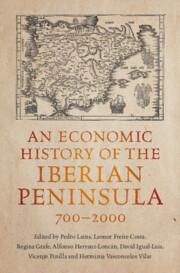Book contents
- An Economic History of the Iberian Peninsula, 700–2000
- An Economic History of the Iberian Peninsula, 700–2000
- Copyright page
- Contents
- Figures
- Tables
- Contributors
- Preface: By Way of Presentation
- Introduction
- Part I The Making of Iberia, 700–1500
- Section I The Early Middle Ages, 700–1200
- Section II The Medieval Economy, 1000–1500
- 2 Production, 1000–1500
- 3 Population, 1000–1500
- 4 The Polity, 1000–1500
- 5 Money, Credit and Banking, 1000–1500
- 6 Technology, 1000–1500
- 7 Living Standards, 1000–1500
- 8 International Trade and Commerce, 1000–1500
- 9 The Iberian Economy in Global Perspective, 700–1500
- Part II Globalization and Enlightenment, 1500–1800
- Part III Industrialization and Catching Up, 1800–2000
- References
- Index
9 - The Iberian Economy in Global Perspective, 700–1500
from Section II - The Medieval Economy, 1000–1500
Published online by Cambridge University Press: 22 February 2024
- An Economic History of the Iberian Peninsula, 700–2000
- An Economic History of the Iberian Peninsula, 700–2000
- Copyright page
- Contents
- Figures
- Tables
- Contributors
- Preface: By Way of Presentation
- Introduction
- Part I The Making of Iberia, 700–1500
- Section I The Early Middle Ages, 700–1200
- Section II The Medieval Economy, 1000–1500
- 2 Production, 1000–1500
- 3 Population, 1000–1500
- 4 The Polity, 1000–1500
- 5 Money, Credit and Banking, 1000–1500
- 6 Technology, 1000–1500
- 7 Living Standards, 1000–1500
- 8 International Trade and Commerce, 1000–1500
- 9 The Iberian Economy in Global Perspective, 700–1500
- Part II Globalization and Enlightenment, 1500–1800
- Part III Industrialization and Catching Up, 1800–2000
- References
- Index
Summary
This chapter aims to tie together many of the themes in the preceding chapters with a four-fold strategy. First, it sets out a general overview of the Iberian economy during the medieval period. This includes an analysis of how and why the economic balance of power shifted from the Islamic to the Christian states during the medieval centuries. Then, it provides a broader picture of some major developments in the peri-Iberian European and Islamic-Mediterranean economies in the medieval period, including micro- and macroeconomic developments. Third, this chapter shows how different regions of Iberia connected with elements of the peri-Iberian economies set out in the previous section; specifically how the Islamic states maintained ties with North Africa and points further afield; how the Christian North and West connected with the northern Atlantic economy; how the south-west eventually built ties with the Atlantic islands, West Africa, and more distant markets; and how the Eastern peninsula maintained ties with various Mediterranean markets. Finally, the chapter ends with some general conclusions, including the idea that, as this volume amply shows, it is high time to dispel any lingering sense of an economic “Black Legend” when discussing the economy of medieval Iberia.
Keywords
- Type
- Chapter
- Information
- An Economic History of the Iberian Peninsula, 700–2000 , pp. 221 - 248Publisher: Cambridge University PressPrint publication year: 2024

